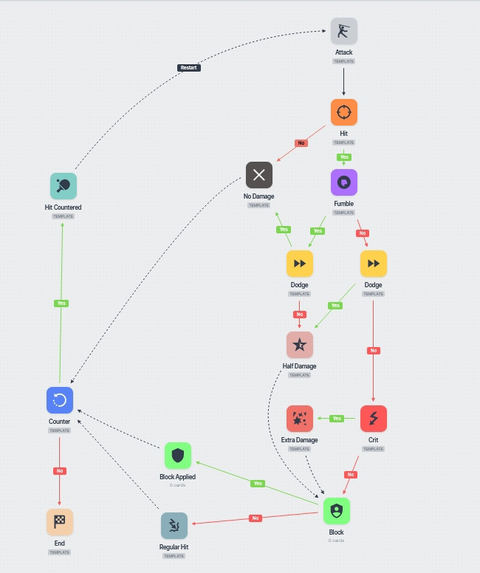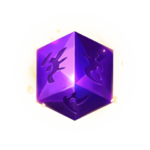Difference between revisions of "Combat Formulas/zh"
| Line 136: | Line 136: | ||
* 行囊左侧兵器槽位的兵器伤害会显示为角色界面的“主手伤害”,所以行囊左侧兵器槽位为“主手槽位”。 | * 行囊左侧兵器槽位的兵器伤害会显示为角色界面的“主手伤害”,所以行囊左侧兵器槽位为“主手槽位”。 | ||
* 行囊右侧兵器槽位的兵器伤害会显示为角色界面的“副手伤害”,所以行囊右侧兵器槽位为“副手槽位”。 | * 行囊右侧兵器槽位的兵器伤害会显示为角色界面的“副手伤害”,所以行囊右侧兵器槽位为“副手槽位”。 | ||
* | * 发动具体兵器类别的技能(例如[[Double Lunge/zh|双刃贯耳]])只会使用相应类别的兵器,无论兵器放在主手还是副手,因此: | ||
** | ** 如果只有“主手槽位”装备了匕首,发动技能将会采用角色界面的“主手伤害”计算伤害结果。 | ||
** | ** 如果只有“副手槽位”装备了匕首,发动技能将会采用角色界面的“副手伤害”计算伤害结果。 | ||
** 如果两个槽位装备的兵器类别相同(两把匕首),发动技能将会采用角色界面的“主手伤害”计算伤害结果。 | ** 如果两个槽位装备的兵器类别相同(两把匕首),发动技能将会采用角色界面的“主手伤害”计算伤害结果。 | ||
** 如果两个槽位装备的兵器类别不同(单手刀剑+匕首),发动技能则会根据相应类别兵器所在的槽位,相应地采用“主手伤害”或者“副手伤害”计算伤害结果。 | ** 如果两个槽位装备的兵器类别不同(单手刀剑+匕首),发动技能则会根据相应类别兵器所在的槽位,相应地采用“主手伤害”或者“副手伤害”计算伤害结果。 | ||
* 如果发动兵器技能以外的技能(例如[[Seize the Initiative/zh|掌握主动]]): | * 如果发动兵器技能以外的技能(例如[[Seize the Initiative/zh|掌握主动]]): | ||
** | ** 如果只装备了一件兵器,游戏会采用兵器所在槽位对应的伤害。 | ||
** | ** 如果两手均装备了兵器,游戏会优先使用“主手槽位”的兵器和你的“主手伤害”。 | ||
* [[Dual Wielding Training]] | * 技能[[Dual Wielding Training/zh|双持训练]]有可能采用“主手伤害”,也有可能采用“副手伤害”,具体取决于触发双持训练的技能对应的是你哪一只手的兵器。 | ||
** Using a weapon specific skill (like [[Double Lunge]]) with two weapons of the same type (two Daggers) will use your displayed '''Main Hand Damage''' for the skill and your '''Off-Hand Damage''' for the DWT attack. | ** Using a weapon specific skill (like [[Double Lunge]]) with two weapons of the same type (two Daggers) will use your displayed '''Main Hand Damage''' for the skill and your '''Off-Hand Damage''' for the DWT attack. | ||
** Using a weapon specific skill (like [[Double Lunge]]) with two weapons of a different type (Sword + Dagger), with '''Sword''' in the '''Main Hand slot''' will use '''Off-Hand Damage''' for the specific weapon skill, then it will use the '''Main Hand Damage''' for the DWT attack. | ** Using a weapon specific skill (like [[Double Lunge]]) with two weapons of a different type (Sword + Dagger), with '''Sword''' in the '''Main Hand slot''' will use '''Off-Hand Damage''' for the specific weapon skill, then it will use the '''Main Hand Damage''' for the DWT attack. | ||
Revision as of 19:02, 13 January 2023
《紫色晶石》采用回合制系统,许多配套系统与之相关,而且彼此密切联系。 这个系统的基本规则是玩家角色行动一个回合,所有敌人也会行动一个回合。玩家角色目前没有办法获得额外的回合,敌人也无法获得额外的回合。角色每个回合可以进行各种行动。
玩家角色模式
你在探索《紫色晶石》的世界时,会遇到各种各样的情况。你会走进林间、村庄、草原,你会与城乡的居民对话,会战斗和休息。为了表现屏幕上发生的事情,游戏设计了多个模式,模式不同,游戏的行为也有所不同。有些模式可以手动启用,有些则自动启用。
冒险模式
冒险模式是游戏的默认模式,其他模式取消之后,玩家角色就会回到冒险模式。冒险模式期间,玩家使用回合不受限制。你在屏幕的某个位置点击鼠标之后,角色就会直接移向目标方格,中间不会停顿。如果你看到了 NPC,例如村里的乡亲或者林间的鹿,他们会随着你的移动按照自己的路线移动,从而造成流畅移动的错觉。事实上,他们移动的回合数量始终与你的角色移至目标方格所用回合的数量相同。
如果NPC看到你之后出现敌意,你有可能继续移动,也有可能停止移动,具体情况因对方是哪种NPC而异。
以下NPC不会打断你的移动:
- 城乡居民
- 鹿、狐狸、驼鹿、松鼠、兔子和高鼻羚羊,这些属于中立动物。它们出现敌意的时候,只会逃跑,不会攻击你,也不会打断你的移动。(它们无路可走或者移动受限的时候,有可能发动攻击,不过这种情况比较罕见)
战斗模式
附近出现敌意的敌人,战斗模式就会立刻开始。除了上述中立敌人之外,所有NPC出现敌意,都会令你进入战斗状态。
战斗模式期间,玩家角色使用回合会受到限制。每次只能执行一个行动。玩家每次行动之后,同一块地图的所有NPC都会行动一次,然后再由玩家角色行动。附近所有存在敌意的敌人全部击杀之后,战斗模式就会结束。由于战斗以回合为单位进行,要想跑得比敌人快,就必须依靠位移、突进技能。即便你想在地图边缘连续切换地图,战斗模式也不会因此而结束,因为附近多数存在敌意的敌人会跟着你进入另外一块地图。目前走出地城可以终止战斗模式,因为敌人不会跟你走出地城,但能跟着你往返地城的不同楼层。
战斗模式生效期间,你也无法进入休息模式,角色会说:“附近有敌人,不能休息。”
休息模式
休息模式期间,玩家角色会原地坐下休息。休息模式与连续按空格键跳过回合类似,只是休息模式会自动跳过回合,而且回合跳过的速度较快。除非取消或有存在敌意的敌对NPC接近,否则休息模式就会一直生效。休息模式期间,你的生命自动恢复、治疗效果和精力自动恢复会提升,不过你的视野会大大缩小,所以休息务必找个安全的地方。
“提示:要想在地城里面休息,建议清除所在房间的敌人之后,然后关上房门;或者回到地城已经荡清的楼层。”
休息模式的默认快捷键是R。
攻击模式
按Ctrl键可以进入或退出攻击模式,冒险模式和战斗模式都可以切换为攻击模式。玩家角色进入攻击模式之后,无论选中什么方格,都不能互动,只能攻击。这种时候,你不仅可以攻击敌人,也能攻击环境里的所有物体,例如板凳、桌子、雕像以及容器和门等可以互动的物体。
启用攻击模式之后,远程兵器可以放心攻击敌人,不用担心不小心往前走了一步。
潜行模式
游戏目前无法进入潜行模式,暂时也不知道潜行模式会有哪些效果,不过属性“潜行”的说明文本提到了这个模式。
以下行动消耗回合
执行以下行动需要消耗一个回合:
- 移动
- 攻击
- 拿起地上的物品
- 运用技能(例如探查)
- 使用物品(使用医药用途、进食、进水、阅读书卷字条,附魔物品、鉴定物品、打开背包等等)
- 打开容器(尸体、坟墓、箱子、架子、石棺……)
- 与环境物体互动(面向神龛祈祷、开门、拆除陷阱……)
- 叫喊
- 投掷物品
以下行动不消耗回合
攻击
现在看一看攻击的规则。简而言之,每次发生攻击,游戏都会得出一个结果,可以是“命中”,也可以是“未命中”。如果你攻击的结果为“命中”,则会令目标失去一定量的生命。这个量是你的“伤害”减去目标相应“抗性”与/或“防护”的结果,不过这一计算背后的机制兵没有那么简单。
命中与未命中
游戏需要判断你的攻击是否突破目标的防护与抗性时,首先会判定攻击的性质。攻击分为以下两种:
- 兵器攻击:挥舞近战兵器、使用远程兵器或者运用需要配备兵器的技能,这类攻击包括可以造成秘术伤害等魔法伤害的兵器攻击。
- 法术攻击:运用某些法咒或者类似战吼之类的技能。
兵器攻击会套用你的准度属性,然后将其与目标的闪躲几率(玩家无法查看)进行比较。
示例:假设我的准度为100%,我的目标闪躲几率为10%,那么我对其发动的攻击就有90%的几率命中。 游戏在1到100这个区间随机取了一个数字,结果是47,那么因为47低于90,所以我的攻击会命中。
法术只有连发火球和放电这两个需要套用准度,其他法咒均不套用准度,必中。
弓弩射箭与连发火球和放电除了准度判定之外,还会判断投射路径上有无其他物体,比如门、橱柜等。如果存在物体,你的投射就有一定几率偏向,转而击中这个物体。这一规则的具体原理不明。
最后,还有一些特殊情况。
例如,穿身箭会对箭矢飞行轨迹的所有对象造成伤害,与熔岩之火相似。不过,直线射向正左、正右两个方向的时候,箭矢有时会飞跃你与目标方格之间的敌人,不对他们造成伤害。
暴击与失手
假设我们的攻击命中了,那么就要考虑是哪一种命中了。总共有三种结果,依次分别如下:
- 失手 - 与失手几率有关。失手表示你运气不好,攻击没有完全击中目标,或者你的攻击或法术失败了。这种时候,你攻击的类别会再次产生影响。
- 暴击/奇观 - 近身攻击与远程攻击受暴击几率影响,法术则受奇观几率影响。暴击表示你运气好,击中了目标的要害或者穿透了目标的护甲,所以造成了更大的伤害。奇观则表示你的施法效果比平时更加强大。
- 正常命中 - 你击中了目标,造成了全额的伤害。
暴击/奇观
你的正常伤害会与暴击效果相乘。如果你的攻击带有魔法伤害(灼烧伤害 +8),魔法伤害不会与暴击效果相乘。
你法咒的伤害与二级效果会与奇观效果相乘。
除了伤害增加以外,近身攻击与远程攻击的暴击还会有额外的特殊效果,具体因所用兵器的类别而异:
- 单手刀、剑:出血几率+50%。
- 单手斧:肢体伤害+50%。
- 单手锤、棒:击晕几率+50%。
- 匕首:暴击效果+50%,令目标损耗精力上限10%的精力。
- 双手刀、剑:攻击三个方格,出血几率+75%。
- 双手斧:攻击三个方格,肢体伤害+75%。
- 双手锤、棒:攻击三个方格,击晕几率+75%。
- 单手锤、棒:攻击三个方格,立即恢复精力上限10%的精力。
- 长杆刃器:限制移动几率+75%。
- 弓:限制移动几率+50%。
- 弩:击退几率+125%。
奇观的特殊效果因法术而异。例如,连发火球奇观会额外造成伤害,炎狱奇观会延长炎狱的持续时间。
失手
如果你的攻击命中目标,而且不是暴击,也不是失手,那么你的攻击会对目标造成足量伤害。
反击
近战敌人对你发动攻击时,你受到、闪躲或格挡此次攻击有一定几率自动对攻击者发动一次普通攻击,即“反击”。这个几率由属性反击几率决定。NPC也有反击几率,也可以发动反击。反击触发的效果与常规普通攻击相同,例如反击也能造成出血。
趁机攻击
趁机攻击属于普通攻击,会在“临近方格的敌人远离你”时触发。玩家远离临近方格的敌人时,也有可能触发敌人的趁机攻击。趁机攻击的触发几率为50%,学习技能脱身能够降低这一几率。
新手玩家一番近战之后,看到局势不妙,常常会犯贸然逃跑的错误,只会令局面对自己更加不利,因为这种行为只会频繁触发敌人的趁机攻击。要想避免这种情况,建议想方设法消灭距离最近的敌人,或者至少令其眩晕或移动受限之后再逃跑。你还可以利用地形(墙角)。
主手伤害与副手伤害
你的角色界面会显示“主手伤害”与“副手伤害”这两个属性,你的兵器攻击和兵器技能造成的伤害不是由前者决定,就是由后者决定。角色界面显示的这两项数值源自你所装备的兵器,也会受到主手效果与副手效果的影响。你的攻击类别以及兵器置于主手还是副手,这两个因素都会左右伤害计算所套用的伤害属性。具体规则如下:
- 行囊左侧兵器槽位的兵器伤害会显示为角色界面的“主手伤害”,所以行囊左侧兵器槽位为“主手槽位”。
- 行囊右侧兵器槽位的兵器伤害会显示为角色界面的“副手伤害”,所以行囊右侧兵器槽位为“副手槽位”。
- 发动具体兵器类别的技能(例如双刃贯耳)只会使用相应类别的兵器,无论兵器放在主手还是副手,因此:
- 如果只有“主手槽位”装备了匕首,发动技能将会采用角色界面的“主手伤害”计算伤害结果。
- 如果只有“副手槽位”装备了匕首,发动技能将会采用角色界面的“副手伤害”计算伤害结果。
- 如果两个槽位装备的兵器类别相同(两把匕首),发动技能将会采用角色界面的“主手伤害”计算伤害结果。
- 如果两个槽位装备的兵器类别不同(单手刀剑+匕首),发动技能则会根据相应类别兵器所在的槽位,相应地采用“主手伤害”或者“副手伤害”计算伤害结果。
- 如果发动兵器技能以外的技能(例如掌握主动):
- 如果只装备了一件兵器,游戏会采用兵器所在槽位对应的伤害。
- 如果两手均装备了兵器,游戏会优先使用“主手槽位”的兵器和你的“主手伤害”。
- 技能双持训练有可能采用“主手伤害”,也有可能采用“副手伤害”,具体取决于触发双持训练的技能对应的是你哪一只手的兵器。
- Using a weapon specific skill (like Double Lunge) with two weapons of the same type (two Daggers) will use your displayed Main Hand Damage for the skill and your Off-Hand Damage for the DWT attack.
- Using a weapon specific skill (like Double Lunge) with two weapons of a different type (Sword + Dagger), with Sword in the Main Hand slot will use Off-Hand Damage for the specific weapon skill, then it will use the Main Hand Damage for the DWT attack.
- Using a weapon specific skill (like Double Lunge) with two weapons of a different type (Sword + Dagger), with Dagger in the Main Hand slot will use Main Hand Damage for the specific weapon skill, then it will use the Off-Hand Damage for the DWT attack.
- Using a non-weapon specific skill (like Seize the Initiative) with two weapons of a different type (Sword + Dagger), it will prioritize the weapon in your Main Hand slot and use your Main Hand Damage for the non-weapon specific skill, then it will use the Off-Hand Damage for the DWT attack.
Defending
With the final result from the attacker's side, we switch to the defender to see how much damage was caused. There are three types of defenses and these are applied in this order:
- Blocking - The defender blocks/deflects incoming attacks, lessening their impact. If the defender has a Shield, they can also Block ranged attacks. Spells cannot be blocked.
- Protection - The defender receives the attack, but its effects are partially or completely negated thanks to the defender's Armor.
- Resistances - The defender is less susceptible to certain damage types, either thanks to Armor (Plate armor is harder to get through), naturally (Bears have thick hides, Fire is less effective if you're Wet) or magically (the Tutorial/Prologue boss was magically strenghtened from the ritual).
Blocking
Block Chance affects whether an attack will be Blocked. If a Block occurs, the incoming damage is reduced by an amount of defender's Block Power, depending on the damage type of the attack.
- If the attack deals Physical damage, 1 Block Power is used for every 1 point of incoming damage.
- If the attack deals Nature damage or Magic damage, 2 Block Power is used for every 1 point of incoming damage.
Example: A Necromancer attacks me using the Necromancer Staff. His attack is a Hit, and there is a total of 27 damage going my way, 17 Crushing damage and 10 Unholy damage. I have Blocked the attack and my Block Power is full at 30/30.
- I have enough Block Power to completely Block the 17 Crushing damage, which leaves 30-17 = 13 Block Power remaining.
- Since Unholy is a Magic Damage type, my remaining Block Power is only 50% effective, therefore I Block 13/2 = 7 (rounded up) out of the 10 Unholy damage.
Thanks to Blocking, I will take only 3 Unholy damage. However, my Block Power is now depleted. If I were to take another attack right away, I would not be able to Block any damage.
Block Power automatically replenishes by your amount of Block Power Recovery %.
Example: I'm at 0/30 Block Power. I have 20% Block Power Recovery, therefore I will recover 30*0,2 = 6 Block Power every turn.
Blocking with a Shield causes Durability damage to the equipped Shield.
Blocking without a Shield causes Durability damage to the equipped Weapons.
Protection
Protection reduces attack damage by a flat amount each time damage is received. Protection is always active.
- If the attack deals Physical damage, every 1 point of Protection reduces the incoming damage by 1 point.
- If the attack deals Nature or Magic damage, every 2 points of Protection reduce the incoming damage by 1 point.
Protection is separated into four different values that cover different Body Parts:
- Head, which protects your Head bodypart and uses the Protection value from Helmets.
- Chest, which protects your Torso bodypart and uses the Protection value from Chestpieces.
- Arms, which protects your Left Arm and Right Arm bodyparts and uses the Protection value from Gloves.
- Legs, which protects your Left Leg and Right Leg bodyparts and uses the Protection value from Boots.
The bodypart that is targeted during an attack is chosen at random, therefore it is very important to protect all bodyparts from incoming damage.
Certain skills will always target specific bodyparts, for example Nail Down or Headshot.
Example: An attack targets my Right Leg and hits me for 17 Crushing damage. I'm wearing Splinted Boots with 8 Protection, therefore I will take only 17-8 = 9 Crushing damage.
Example: An attack targets my Right Leg and hits me for 10 Fire damage. I'm wearing Splinted Boots with 8 Protection, but Fire is Nature damage type, therefore I will take 10-(8/2) = 6 Fire damage.
Resistances
Resistances are a type of defenses that is applied each time a corresponding effect is received. Resistances are always percentages.
There are four types of Resistances:
- Resistance to a single damage type - For example, Rending Resistance will only reduce incoming Rending damage.
- Resistance to a group of damage types - For example, Physical Resistance will reduce incoming damage from these 4 Damage Types: Slashing, Piercing, Crushing and Rending damage.
- Resistance to harmful Status Effects - For example, Control Resistance will reduce the chance to receive Stun, Daze and Stagger effects as well as their duration.
- Resistance to negative health system effects - For example, Pain Resistance will cause your character to accumulate Pain slower.
Example: An attack hits me for 10 Fire damage. I have the Wet condition from the Rain, which gives me a total 50% Fire Resistance, so I will only take 5 Fire damage.
See Damage Types for all available damage types and their groups. See Attributes & Stats for all available Resistance attributes.
Secondary Effects
Attacks don't just reduce the target's health, but can also apply various other effects. These effects can come naturally from your attack, from having beneficial Status Effects active or from using Skills. Combining various secondary effects is key to mastering combat in Stoneshard.
There are many various effects. Feel free to look through the different Skills' descriptions.
Secondary Effects can happen when:
- An attack hits or crits
- An attack meets certain criteria (target is affected by certain Conditions, attacking kills the target, ...)
- Your attributes meet certain criteria (when energy is below certain threshold, when weapon durability is above certain threshold, ...)
Summary
See Also
本页最后一次更新时间:补丁: 0.8.0.27
| ||||||||||||||||||||||||||||
| |||||

